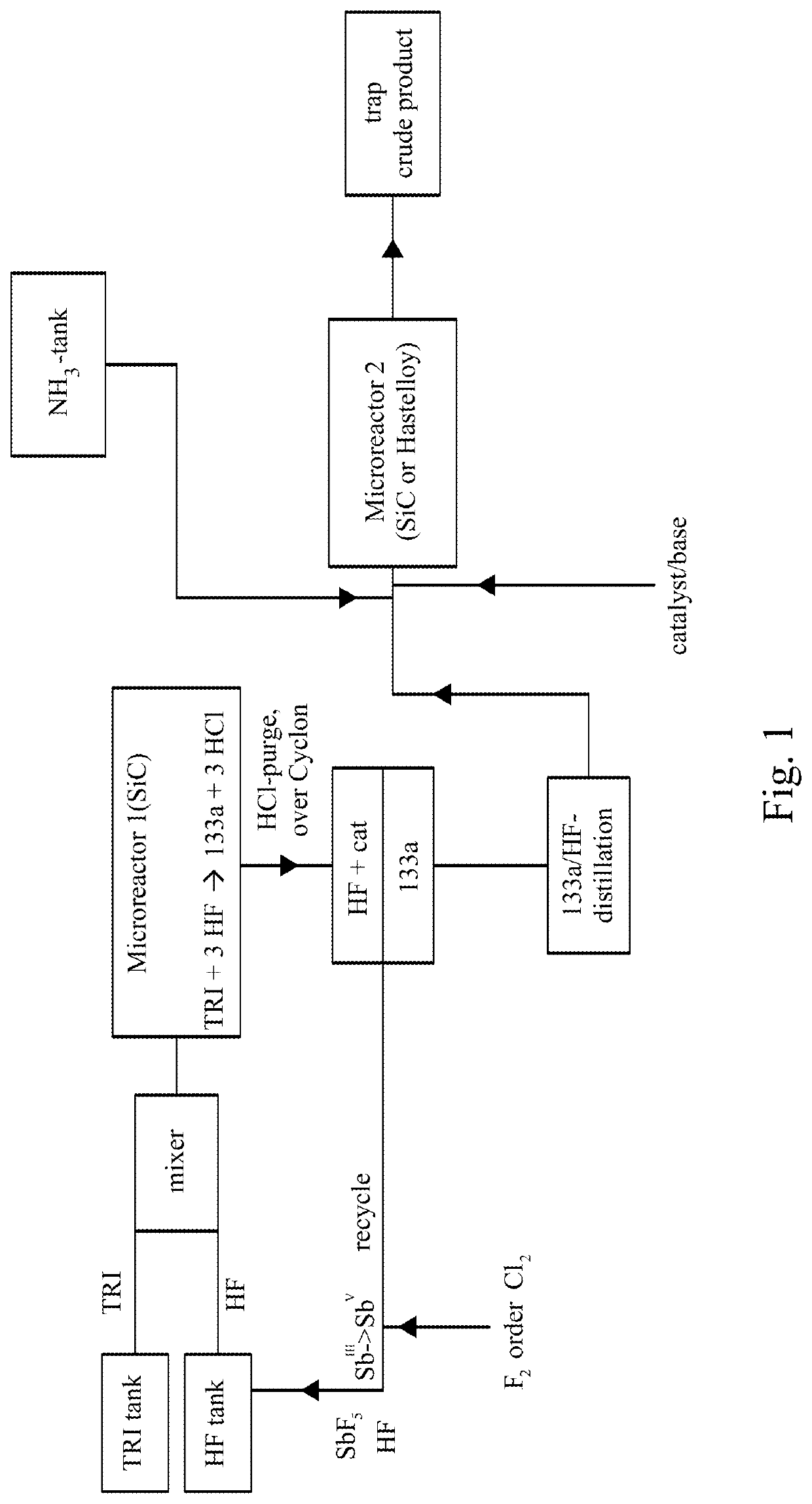Process for the Manufacture of Trifluoroethylamine
a technology of trifluoroethylamine and manufacturing process, which is applied in the preparation of halogenated hydrocarbons, physical/chemical process catalysts, hydrogen halide split-off, etc., can solve the problems of high energy demand, reduce simplify the process, and avoid time and energy consumption. , the effect of reducing the number of separation steps
- Summary
- Abstract
- Description
- Claims
- Application Information
AI Technical Summary
Benefits of technology
Problems solved by technology
Method used
Image
Examples
example 1
Pre-Fluorination Procedure in Autoclave:
[0115]
[0116]In a 250 ml autocalve (high grade stainless steel 1.4571, Roth company, 1 deep pipe made out of plastics, 1 outlet over gas phase) with HDPTFE Inliner and magnetic stirrer, 36.78 g (0.123 mol) SbCl5 are placed, the autoclave is closed and a 20 fold molar excess of HF (waterfree) (2.46 mol, 49.22 g) is fed from a HF cylinder's liquid phase (cylinder has to be pressurized before with N2) into the autoclave. Even if pressure in the autoclave raises already immediately through the formed HCl in the autoclave after contact with HF, the autoclave is stirred with said magnetic stirrer and heated in an oil bath or electrical heater for 3 h to 100° C. to get an almost complete exchange of Chlorine atoms by fluorine atoms. The pressure on the autoclave is very carefully OVER THE GAS PHASE exit of the autoclave released after cooling down of the autoclave to room temperature to atmospheric pressure into a (just water containing) scrubber (the...
example 2
Fluorination Step in (Batch) Autoclave:
[0117]
[0118]100.0 g (4,998 mol) fresh HF were added into the autoclave over the deep pipe at room temperature, then 62.14 g (0.473 mol) Trichloroethylen (TCE) were dosed with an HPLC pump over the deep pipe into the autoclave (also at room temperature), pressure will start to raise. The autoclave is heated in an oil bath or electrically to 100° C. for 1 h (better 2 h). The pressure will rise constantly. Afterwards, after cooling to room temperature, the pressure is slowly and very carefully released OVER THE GAS PHASE exit of the autoclave to atmospheric pressure into a scrubber with fresh ice water (work up step 1, not with the scrubber water already used for the pre-fluorination), a 2nd phase will be optionally formed already, especially during the end of pressure release. Now the autoclave either is pressurized again over the gas phase inlet of the autoclave with N2 pressure and the remaining content in the autoclave is carefully fed into th...
example 3
Continuous Example Connected with Amination Step
Fluorination Step:
[0119]TRI was fed out of a storage tank together with HF (molar ration TRI / HF=1:9) containing 10 mol % SbF5 (prepared according to the pre-fluorination procedure in batch) into a ChemtrixMicroreactor (27 ml) made out of SiC heated to 110° C., feed is controlled over a process control system securing a residence time of 200 seconds. A cylon, where a pressure valve is keeping 20 bar pressure, is used after the microreactor to remove some HCl before the mixture goes into a settler to separate organic phase with the 133a and a HF phase containing the catalyst and some HCl. The organic phase is subjected to a pressure distillation to get pure (HF free) 133a. There is a storage (or puffer) tank after the 133a distillation.
Amination Step (NH3 as Cl-Scavenger):
[0120]133a is fed together with liquid NH3 into a 2nd microreactor. This reactor can be out of stainless steel or also SiC (volume 27 ml). This reactor is heated to 190...
PUM
| Property | Measurement | Unit |
|---|---|---|
| flow rate | aaaaa | aaaaa |
| temperature | aaaaa | aaaaa |
| pressure | aaaaa | aaaaa |
Abstract
Description
Claims
Application Information
 Login to View More
Login to View More - R&D
- Intellectual Property
- Life Sciences
- Materials
- Tech Scout
- Unparalleled Data Quality
- Higher Quality Content
- 60% Fewer Hallucinations
Browse by: Latest US Patents, China's latest patents, Technical Efficacy Thesaurus, Application Domain, Technology Topic, Popular Technical Reports.
© 2025 PatSnap. All rights reserved.Legal|Privacy policy|Modern Slavery Act Transparency Statement|Sitemap|About US| Contact US: help@patsnap.com



